The global quantum imaging devices market is projected to grow from USD 1,150.7 million in 2025 to approximately USD 6,493.7 million by 2035, recording an absolute increase of USD 5,343.0 million over the forecast period. This translates into a total growth of 464.4%, with the market forecast to expand at a compound annual growth rate (CAGR) of 18.90% between 2025 and 2035.
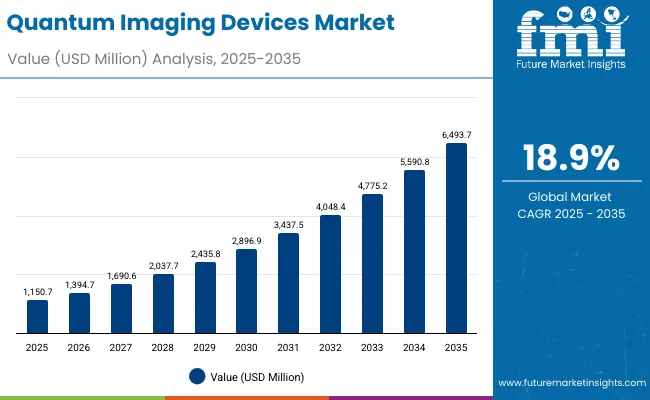
Quantum Imaging Devices Market Key Takeaways
| Metric | Value |
|---|---|
| Estimated Value in (2025E) | USD 1,150.7 million |
| Forecast Value in (2035F) | USD 6,493.7 million |
| Forecast CAGR (2025 to 2035) | 18.90% |
The overall market size is expected to grow by approximately 5.6X during the same period, supported by increasing demand for advanced medical imaging technologies, growing adoption of quantum sensing applications, and rising investment in quantum technology research across the global healthcare and research sectors.
Between 2025 and 2030, the quantum imaging devices market is projected to expand from USD 1,150.7 million to USD 2,734.5 million, resulting in a value increase of USD 1,583.8 million, which represents 29.6% of the total forecast growth for the decade. This phase of development will be shaped by increasing adoption of quantum sensing technologies, rising demand for ultra-sensitive medical imaging solutions, and growing utilization in neuroimaging and molecular imaging applications. Medical device manufacturers and quantum technology specialists are expanding their product portfolios to address the growing preference for high-precision quantum imaging systems in clinical and research environments.
From 2030 to 2035, the market is forecast to grow from USD 2,734.5 million to USD 6,493.7 million, adding another USD 3,759.3 million, which constitutes 70.4% of the overall ten-year expansion. This period is expected to be characterized by the advancement of quantum sensing technologies, the integration of artificial intelligence with quantum imaging platforms, and the development of specialized quantum devices for personalized medicine applications. The growing emphasis on early disease detection and precision medicine will drive demand for advanced quantum imaging systems with enhanced sensitivity and improved diagnostic capabilities.
Between 2020 and 2024, the quantum imaging devices market experienced rapid growth, expanding from USD 543.2 million to USD 981.8 million, driven by increasing investment in quantum technology research, growing recognition of quantum imaging advantages in medical diagnostics, and expanding applications across neuroimaging and molecular imaging sectors. The market developed as healthcare providers and research institutions recognized the potential for quantum imaging to revolutionize medical diagnostics while meeting modern healthcare requirements for ultra-sensitive detection capabilities.
The quantum imaging devices market represents a revolutionary healthcare technology opportunity at the intersection of quantum physics, advanced medical imaging, and precision diagnostics, with the market projected to expand from USD 1,150.7 million in 2025 to USD 6,493.7 million by 2035 at an exceptional 18.90% CAGR a 5.6X growth driven by increasing demand for ultra-sensitive imaging technologies, expanding neuroimaging applications, and the integration of quantum sensing into clinical practice.
This convergence opportunity leverages the growing emphasis on precision medicine, advances in quantum sensing technologies, and the increasing availability of specialized quantum imaging services to create solutions that offer unprecedented sensitivity and diagnostic accuracy. SQUID technology leads with 32.1% market share due to its established clinical applications and proven effectiveness in magnetoencephalography, while hospitals & academic medical centers dominate end user demand as specialized institutions increasingly invest in advanced quantum imaging capabilities. Geographic growth is strongest in China (21.0% CAGR) and India (20.5% CAGR), where expanding healthcare infrastructure and growing quantum technology investment create favorable market conditions.
Pathway A - SQUID Technology Leadership
he dominant technology category offers superior magnetic field sensitivity, established clinical applications, and proven effectiveness in neuroimaging procedures. Companies developing advanced SQUID systems with enhanced sensitivity, improved cryogenic efficiency, and specialized neuroimaging capabilities will capture the leading technology segment. Expected revenue pool: USD 2,000-2,500 million.
Pathway B - Hospital & Academic Medical Center Integration
The largest end user segment benefits from growing institutional investment in quantum imaging capabilities and comprehensive research programs. Providers developing specialized quantum imaging solutions with seamless integration into existing clinical workflows, comprehensive training programs, and clinical outcome optimization will dominate this primary market. Opportunity: USD 2,800-3,200 million.
Pathway C - Advanced Neuroimaging Applications and Precision Enhancement
Next-generation neuroimaging requires sophisticated quantum sensors capable of detecting minute magnetic field variations with unprecedented sensitivity. Companies investing in advanced quantum sensing technologies, enhanced signal processing, and neuroimaging platform integration will create competitive differentiation and premium positioning. Revenue uplift: USD 1,700-2,200 million.
Pathway D - Geographic Expansion in High-Growth Asian Markets
China and India's expanding quantum technology infrastructure and growing healthcare investment create substantial opportunities. Local partnerships, specialized training programs, and culturally adapted quantum imaging approaches enable market penetration in these high-growth regions. Pool: USD 1,200-1,800 million.
Pathway E - Oncology & Molecular Imaging Applications
Cancer detection and molecular imaging represent growing opportunities for quantum-enhanced diagnostic capabilities. Developing quantum imaging systems that enable early cancer detection, molecular-level imaging, and improved diagnostic accuracy addresses growing demand for precision oncology solutions. Expected upside: USD 800-1,200 million.
Pathway F - Preclinical & Pharmaceutical R&D Integration
Drug discovery and preclinical research represent growing opportunities for quantum imaging applications in pharmaceutical development. Systems offering enhanced sensitivity for drug efficacy studies, biomarker detection, and preclinical imaging create enhanced value propositions. USD 600-900 million.
Pathway G - Point-of-Care Quantum Imaging Development
Portable and point-of-care quantum imaging systems require miniaturized quantum sensors compatible with clinical environments. Developing portable quantum imaging solutions for emergency medicine and point-of-care diagnostics expands treatment options and appeals to emergency healthcare providers. Pool: USD 400-600 million.
Pathway H - Premium Research Training and Education Programs
High-end market segments demand comprehensive training, certification programs, and ongoing educational support for complex quantum imaging procedures. Companies developing premium training platforms with simulation capabilities, certification programs, and ongoing technical support will capture premium pricing opportunities. Expected revenue: USD 300-500 million.
Market expansion is being supported by the increasing global demand for ultra-sensitive medical imaging technologies and the corresponding shift toward quantum-enhanced diagnostic capabilities that can provide superior sensitivity and precision while meeting healthcare requirements for early disease detection and personalized medicine applications. Modern healthcare providers are increasingly focused on incorporating advanced quantum imaging techniques to enhance diagnostic accuracy while satisfying demands for comprehensive medical imaging services and specialized research capabilities. Quantum imaging devices' proven ability to deliver exceptional sensitivity, enhanced diagnostic accuracy, and breakthrough research capabilities makes them essential technologies for advanced medical centers and research institutions.
The growing emphasis on precision medicine and early disease detection is driving demand for high-performance quantum imaging devices that can support distinctive diagnostic outcomes and comprehensive medical imaging positioning across hospital, research institute, and pharmaceutical research categories. Healthcare provider preference for technologies that combine quantum sensing excellence with advanced imaging capabilities is creating opportunities for innovative quantum imaging implementations in both traditional and emerging medical imaging applications. The rising influence of quantum technology advancement and medical research initiatives is also contributing to increased adoption of specialized quantum imaging devices that can provide authentic quantum sensing characteristics.
The market is segmented by technology, application, end user, and region. By technology, the market is divided into SQUID, optically pumped magnetometers (OPM), NV-diamond spin sensing, DNP/SEOP hyperpolarization, SPAD/quantum photon detectors, quantum nanophotonics (Q-dots), and others. Based on application, the market is categorized into neuroimaging, oncology & molecular imaging, preclinical/pharma R&D, cardiac electrophysiology/MCG, point-of-care neuro/cardiac, and other research uses. By end user, the market covers hospitals & academic medical centers, research institutes & universities, pharma & biotech (preclinical), CROs, OEMs/integrators (components), and other research uses. Regionally, the market is divided into North America, Europe, East Asia, South Asia & Pacific, Latin America, and the Middle East & Africa.
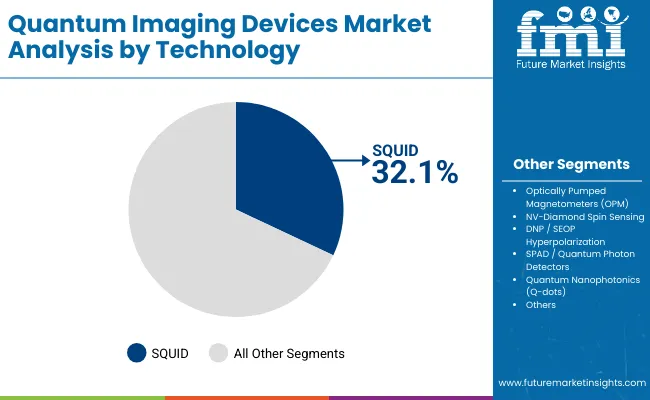
The SQUID (Superconducting Quantum Interference Device) segment is projected to account for 32.1% of the quantum imaging devices market in 2025, reaffirming its position as the leading technology category. Medical device manufacturers and quantum technology producers increasingly utilize SQUID technology for its superior magnetic field sensitivity, established clinical applications, and essential functionality in magnetoencephalography procedures across diverse neuroimaging applications. SQUID technology's proven design elements and established effectiveness directly address the clinical requirements for ultra-sensitive magnetic field detection and optimal diagnostic outcomes in neuroscience research operations.
This technology segment forms the foundation of modern quantum imaging applications, as it represents the technology with the greatest magnetic sensitivity potential and established compatibility across multiple neuroimaging systems. Manufacturer investments in SQUID optimization and specialized design continue to strengthen adoption among medical equipment producers. With healthcare providers prioritizing diagnostic sensitivity and research capabilities, SQUID technology aligns with both clinical effectiveness objectives and research advancement requirements, making them the central component of comprehensive quantum imaging strategies.
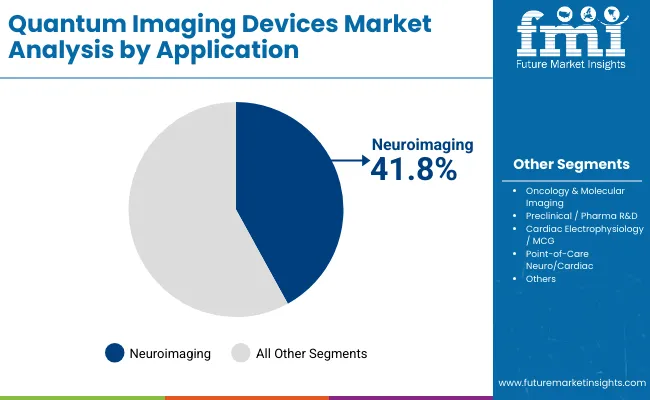
Neuroimaging applications are projected to represent 41.8% of the quantum imaging devices market in 2025, underscoring their critical role as the primary application for advanced brain imaging and neuroscience research. Healthcare providers and researchers prefer neuroimaging applications for their exceptional sensitivity to neural activity, enhanced brain mapping capabilities, and ability to provide non-invasive neural monitoring while supporting advanced neuroscience research requirements during complex brain studies. Positioned as essential applications for high-performance neuroscience research, neuroimaging offers both technological advancement and clinical research advantages.
The segment is supported by continuous advancement in quantum sensing technology and the growing availability of specialized neuroscience research programs that enable enhanced brain imaging and neural activity monitoring at the cellular level. Additionally, neuroscience researchers are investing in advanced quantum imaging techniques to support research excellence and improved understanding of brain function. As quantum imaging technology continues to advance and researchers seek superior sensitivity solutions, neuroimaging applications will continue to dominate the application landscape while supporting neuroscience advancement and research outcome optimization strategies.
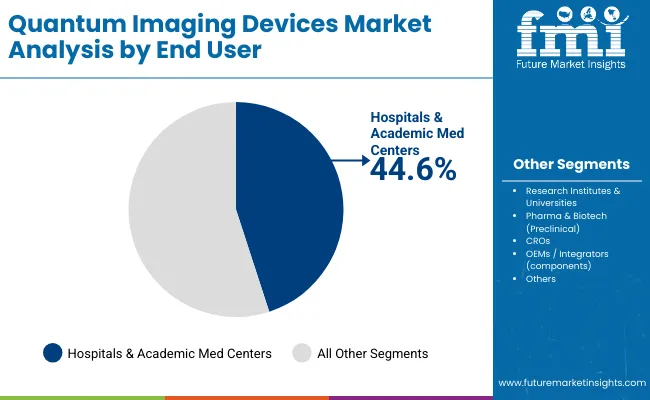
Hospitals & academic medical centers are projected to represent 44.6% of the quantum imaging devices market in 2025, underscoring their critical role as the primary end user for advanced quantum imaging services and comprehensive medical research applications. Healthcare administrators and medical research departments prefer hospital-based quantum imaging services for their comprehensive research capabilities, specialized equipment availability, and ability to provide integrated medical imaging while supporting complex research requirements during advanced diagnostic and research procedures. Positioned as essential facilities for high-performance medical imaging research, hospital centers offer both technological resources and research expertise advantages.
The segment is supported by continuous investment in quantum imaging capabilities and the growing establishment of specialized quantum imaging research programs that enable comprehensive patient care and advanced research outcomes at the institutional level. Additionally, hospitals and academic centers are expanding their quantum imaging services to support research differentiation and comprehensive medical imaging positioning. As quantum imaging technology continues to advance and institutions seek specialized imaging offerings, hospital & academic medical centers will continue to dominate the end user landscape while supporting clinical excellence and comprehensive medical imaging research strategies.
The quantum imaging devices market is advancing rapidly due to increasing investment in quantum technology research and growing demand for ultra-sensitive imaging solutions that emphasize superior diagnostic capabilities across hospital and research applications. However, the market faces challenges, including high equipment costs compared to conventional imaging systems, limited availability of specialized quantum technology expertise, and technical complexity in system integration and maintenance. Innovation in quantum sensing techniques and medical imaging applications continues to influence market development and expansion patterns.
Expansion of Advanced Quantum Sensing Technology Applications
The growing adoption of quantum imaging in comprehensive medical research programs and specialized diagnostic applications is enabling medical device manufacturers to develop products that provide distinctive sensing capabilities while commanding premium positioning and enhanced diagnostic outcome characteristics. Advanced applications provide superior sensitivity while allowing more sophisticated medical imaging development across various healthcare categories and research segments. Manufacturers are increasingly recognizing the competitive advantages of quantum technology positioning for premium product development and medical imaging market penetration.
Integration of AI-Enhanced Quantum Imaging Systems
Modern quantum imaging providers are incorporating advanced artificial intelligence systems, machine learning algorithms, and automated analysis protocols to enhance diagnostic accuracy, improve imaging interpretation, and meet healthcare demands for intelligent quantum imaging solutions. These systems improve diagnostic effectiveness while enabling new applications, including automated anomaly detection and personalized imaging protocols. Advanced AI integration also allows providers to support premium market positioning and clinical excellence leadership beyond traditional medical imaging products.
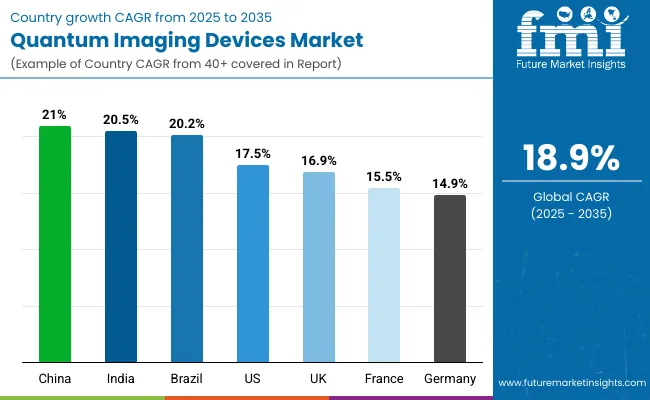
| Country | CAGR (2025 to 2035) |
|---|---|
| China | 21.00% |
| India | 20.50% |
| Brazil | 20.20% |
| USA | 17.50% |
| UK | 16.90% |
| France | 15.50% |
| Germany | 14.90% |
The quantum imaging devices market is experiencing exceptional growth globally, with China leading at a 21.0% CAGR through 2035, driven by massive government investment in quantum technology, expanding healthcare infrastructure, and growing quantum research initiatives. India follows at 20.5%, supported by rising technology investment, expanding medical research capabilities, and growing acceptance of advanced imaging solutions. Brazil demonstrates 20.2% growth, emphasizing quantum technology adoption and healthcare infrastructure development. The USA records 17.5%, focusing on advanced quantum research and medical imaging innovation. The UK shows 16.9% growth, prioritizing quantum technology leadership and medical research excellence. France exhibits 15.5% growth, supported by advanced medical technology and specialized quantum research centers. Germany demonstrates 14.9% growth, focusing on precision engineering and quantum technology development while maintaining market leadership in medical device innovation.
The report covers an in-depth analysis of 40+ countries; seven top-performing countries are highlighted below.
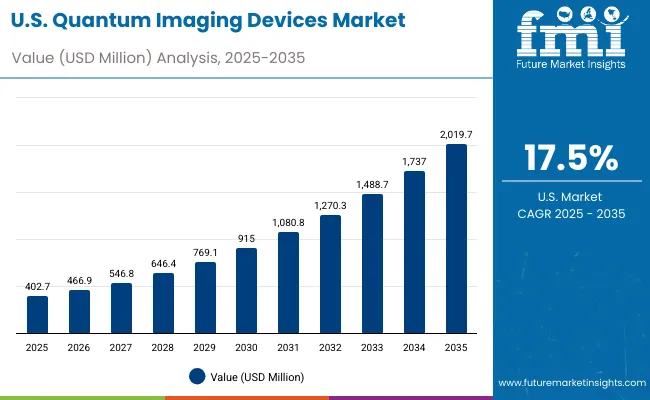
Revenue from quantum imaging devices in the United States is projected to grow at a CAGR of 17.5% through 2035, supported by substantial investment in quantum technology research and strong adoption of advanced imaging technologies across established medical research systems. The country's mature medical device ecosystem, coupled with rising investment in quantum sensing technologies, is driving robust expansion in quantum imaging applications. Leading technology companies and medical research institutions continue to invest in innovation, offering cutting-edge quantum imaging solutions within a well-established research environment.
Revenue from quantum imaging devices in China is projected to exhibit exceptional growth with a CAGR of 21.0% through 2035, driven by massive government investment in quantum technology development and strategic initiatives supporting quantum sensing applications across major research centers. The country's growing quantum technology leadership and increasing investment in medical imaging infrastructure are creating substantial demand for quantum imaging devices in both academic and clinical settings. Major technology companies and research institutions are establishing comprehensive quantum imaging capabilities to serve both domestic research needs and global technology leadership objectives.
Revenue from quantum imaging devices in India is expanding at a CAGR of 20.5%, supported by rising technology investment, growing medical research capabilities, and expanding access to advanced imaging technologies. The country's developing quantum technology infrastructure and increasing acceptance of advanced medical solutions are driving demand for quantum imaging devices across both academic and emerging clinical applications. International technology companies and domestic research institutions are establishing comprehensive quantum imaging networks to address growing market demand for advanced medical imaging solutions.
Revenue from quantum imaging devices in Brazil is projected to grow at a CAGR of 20.2% through 2035, supported by the country's expanding healthcare technology infrastructure, growing medical research investment, and increasing adoption of advanced imaging technologies requiring quantum sensing solutions. Brazilian healthcare providers and research institutions prioritize comprehensive medical imaging capabilities and advanced diagnostic technologies, making quantum imaging devices essential equipment for both academic and clinical applications. The country's comprehensive healthcare development and research advancement patterns support continued market expansion.
Revenue from quantum imaging devices in the United Kingdom is projected to grow at a CAGR of 16.9% through 2035, supported by the country's quantum technology leadership initiatives, expanding medical research sector, and established expertise in advanced imaging requiring specialized quantum sensing solutions. British researchers and medical institutions consistently seek innovative imaging technologies that enhance diagnostic capabilities for both academic research and clinical applications. The country's position as a European quantum technology leader continues to drive innovation in medical imaging applications and research standards.
Revenue from quantum imaging devices in France is projected to grow at a CAGR of 15.5% through 2035, driven by the country's advanced medical research sector, comprehensive healthcare technology systems, and leadership in quantum sensing applications. France's sophisticated research culture and strong support for quantum technology development are creating steady demand for both standard and advanced quantum imaging device varieties. Leading research centers and medical institutions are establishing comprehensive quantum imaging strategies to serve both European markets and growing international research demand.
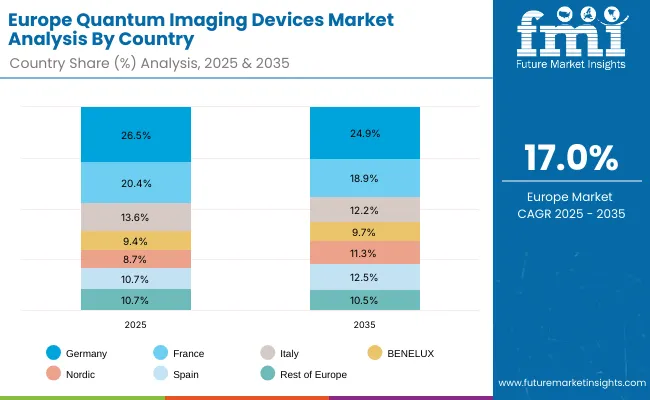
Revenue from quantum imaging devices in Germany is projected to grow at a CAGR of 14.9% through 2035, supported by the country's precision engineering expertise, specialized medical technology sector, and established expertise in quantum sensing procedures. German healthcare providers' focus on precision technology, clinical excellence, and comprehensive research capabilities creates steady demand for quantum imaging devices. The country's attention to technology integration and research outcomes drives consistent adoption across both university medical centers and specialized research facility applications.
The Europe quantum imaging devices market is projected to grow from USD 333.7 million in 2025 to USD 1,604.1 million by 2035, recording a CAGR of 17.0% over the forecast period. Germany leads with a 26.5% share in 2025, slightly decreasing to 24.9% by 2035, supported by advanced precision engineering and strong quantum technology adoption. France follows with 20.4% in 2025, softening to 18.9% by 2035, driven by steady research demand and quantum technology leadership. Italy accounts for 13.6% in 2025, declining to 12.2% by 2035, reflecting moderate growth in quantum research applications. Spain contributes 10.7% in 2025, rising to 12.5% by 2035, supported by increasing investment in quantum technology research. The Nordic countries grow from 8.7% in 2025 to 11.3% by 2035, supported by high per-capita research spending and quantum technology investment. BENELUX holds 9.4% in 2025, rising to 9.7% by 2035, reflecting stable demand growth. The Rest of Europe maintains 10.7% in 2025, decreasing to 10.5% in 2035, reflecting varied growth patterns across smaller research markets.
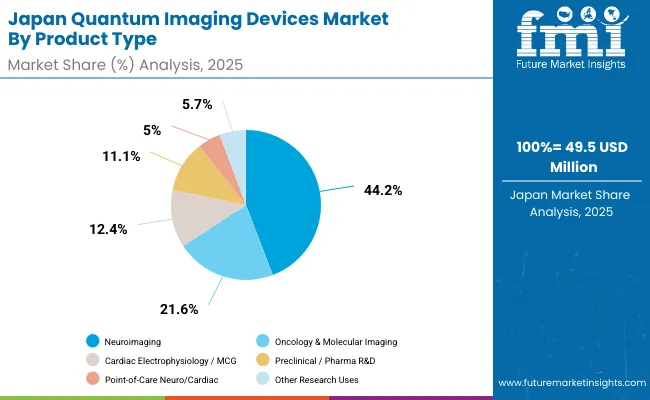
The Japan quantum imaging devices market is valued at USD 49.5 million in 2025, with neuroimaging holding the lead at 44.2% share, supported by demand for advanced brain research applications and neuroscience studies. Oncology & molecular imaging follows with 21.6%, driven by cancer research initiatives and molecular diagnostics adoption. Cardiac electrophysiology/MCG accounts for 12.4%, supported by cardiovascular research applications and cardiac monitoring needs. Preclinical/pharma R&D holds 11.1%, driven by pharmaceutical research requirements and drug development applications. Point-of-care neuro/cardiac represents 5.0%, showing potential for clinical adoption. Other research uses account for 5.7%, reflecting diverse quantum imaging applications in specialized research areas.
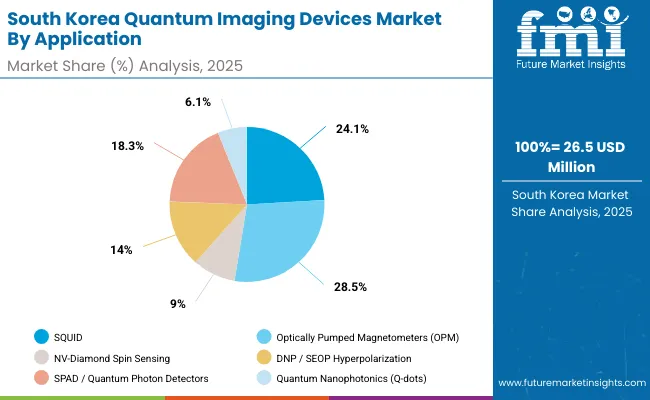
The South Korea quantum imaging devices market is valued at USD 26.5 million in 2025, led by optically pumped magnetometers (OPM) at 28.5% share, supported by rising adoption of portable quantum sensing solutions. SQUID technology holds 24.1%, driven by established neuroimaging applications and research infrastructure. SPAD/quantum photon detectors account for 18.3%, reflecting growing photon counting applications. DNP/SEOP hyperpolarization represents 14.0%, supported by molecular imaging research needs. NV-diamond spin sensing holds 9.0%, showing potential for nanoscale imaging applications. Quantum nanophotonics (Q-dots) accounts for 6.1%, representing emerging quantum dot applications in medical imaging.
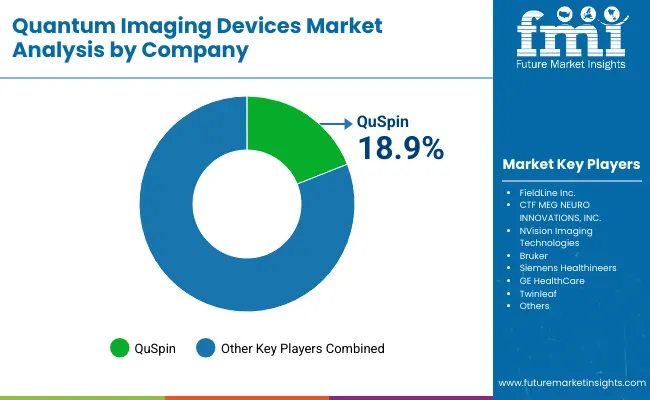
The quantum imaging devices market is characterized by competition among established quantum technology companies, specialized medical device manufacturers, and integrated quantum sensing solution providers. Companies are investing in advanced quantum sensing technologies, specialized device development systems, application-specific innovation, and comprehensive research support capabilities to deliver consistent, high-performance, and effective quantum imaging solutions. Innovation in sensitivity enhancement, signal processing optimization, and customized medical imaging compatibility is central to strengthening market position and research satisfaction.
Ricoh QuSpin leads the market with a strong focus on quantum sensing innovation and comprehensive optically pumped magnetometer solutions, offering advanced quantum imaging systems with emphasis on portability and research effectiveness. FieldLine Inc. provides specialized quantum sensing capabilities with a focus on magnetic field measurement technology and global research distribution networks. CTF MEG delivers integrated magnetoencephalography systems with a focus on advanced neuroimaging and clinical efficiency. NEURO INNOVATIONS, INC. specializes in neuroscience research solutions with an emphasis on quantum imaging applications. NVision Imaging Technologies focuses on comprehensive quantum imaging platforms with advanced technology integration and research support excellence.
Key Players in the Quantum Imaging Devices Market
| Items | Values |
|---|---|
| Quantitative Units (2025) | USD 1,150.7 Million |
| Technology | SQUID, Optically Pumped Magnetometers (OPM), NV-Diamond Spin Sensing, DNP/SEOP Hyperpolarization, SPAD/Quantum Photon Detectors, Quantum Nanophotonics (Q-dots) |
| Application | Neuroimaging, Oncology & Molecular Imaging, Preclinical/Pharma R&D, Cardiac Electrophysiology/MCG, Point-of-Care Neuro/Cardiac, Other Research Uses |
| End User | Hospitals & Academic Medical Centers , Research Institutes & Universities, Pharma & Biotech (Preclinical), CROs, OEMs/Integrators (Components), Other Research Uses |
| Regions Covered | North America, Europe, East Asia, South Asia & Pacific, Latin America, Middle East & Africa |
| Countries Covered | United States, Canada, United Kingdom, Germany, France, China, Japan, South Korea, India, Brazil, Australia and 40+ countries |
| Key Companies Profiled | Ricoh QuSpin , FieldLine Inc., CTF MEG, NEURO INNOVATIONS INC., NVision Imaging Technologies, Bruker, Siemens Healthineers , GE HealthCare, and Twinleaf |
The global quantum imaging devices market is estimated to be valued at USD 1,150.7 million in 2025.
The quantum imaging devices market is projected to reach USD 6,493.7 million by 2035.
The quantum imaging devices market is expected to grow at a 18.90% CAGR between 2025 and 2035.
The key technologies in the quantum imaging devices market are SQUID, optically pumped magnetometers (OPM), NV-diamond spin sensing, DNP/SEOP hyperpolarization, SPAD/quantum photon detectors, and quantum nanophotonics (Q-dots).
In terms of end users, hospitals & academic medical centers are anticipated to command 44.6% share of the quantum imaging devices market in 2025.






Our Research Products

The "Full Research Suite" delivers actionable market intel, deep dives on markets or technologies, so clients act faster, cut risk, and unlock growth.

The Leaderboard benchmarks and ranks top vendors, classifying them as Established Leaders, Leading Challengers, or Disruptors & Challengers.

Locates where complements amplify value and substitutes erode it, forecasting net impact by horizon

We deliver granular, decision-grade intel: market sizing, 5-year forecasts, pricing, adoption, usage, revenue, and operational KPIs—plus competitor tracking, regulation, and value chains—across 60 countries broadly.

Spot the shifts before they hit your P&L. We track inflection points, adoption curves, pricing moves, and ecosystem plays to show where demand is heading, why it is changing, and what to do next across high-growth markets and disruptive tech

Real-time reads of user behavior. We track shifting priorities, perceptions of today’s and next-gen services, and provider experience, then pace how fast tech moves from trial to adoption, blending buyer, consumer, and channel inputs with social signals (#WhySwitch, #UX).

Partner with our analyst team to build a custom report designed around your business priorities. From analysing market trends to assessing competitors or crafting bespoke datasets, we tailor insights to your needs.
Supplier Intelligence
Discovery & Profiling
Capacity & Footprint
Performance & Risk
Compliance & Governance
Commercial Readiness
Who Supplies Whom
Scorecards & Shortlists
Playbooks & Docs
Category Intelligence
Definition & Scope
Demand & Use Cases
Cost Drivers
Market Structure
Supply Chain Map
Trade & Policy
Operating Norms
Deliverables
Buyer Intelligence
Account Basics
Spend & Scope
Procurement Model
Vendor Requirements
Terms & Policies
Entry Strategy
Pain Points & Triggers
Outputs
Pricing Analysis
Benchmarks
Trends
Should-Cost
Indexation
Landed Cost
Commercial Terms
Deliverables
Brand Analysis
Positioning & Value Prop
Share & Presence
Customer Evidence
Go-to-Market
Digital & Reputation
Compliance & Trust
KPIs & Gaps
Outputs
Full Research Suite comprises of:
Market outlook & trends analysis
Interviews & case studies
Strategic recommendations
Vendor profiles & capabilities analysis
5-year forecasts
8 regions and 60+ country-level data splits
Market segment data splits
12 months of continuous data updates
DELIVERED AS:
PDF EXCEL ONLINE
Quantum Photonics Market Size and Share Forecast Outlook 2025 to 2035
Quantum Detector Market Size and Share Forecast Outlook 2025 to 2035
Quantum Cascade Laser Market Size and Share Forecast Outlook 2025 to 2035
Quantum Sensors Market Size and Share Forecast Outlook 2025 to 2035
Quantum Cascade Lasers Market Growth - Trends & Forecast 2025 to 2035
Quantum Computing Market Growth – Trends & Forecast 2025 to 2035
Quantum Cryptography Market Insights - Growth & Forecast 2025 to 2035
Quantum Dot Market Analysis by Application, End-Use Industry, Material Type, Technology, and Region Through 2035
Post-Quantum Cryptography (PQC) Migration Market Analysis - Size, Share, and Forecast Outlook 2025 to 2035
Automotive Quantum Computing Market Size and Share Forecast Outlook 2025 to 2035
Integrated Quantum Optical Circuits Market Size and Share Forecast Outlook 2025 to 2035
ADC & DAC In Quantum Computing Market Size and Share Forecast Outlook 2025 to 2035
Superconducting Quantum Chip Market Size and Share Forecast Outlook 2025 to 2035
Photonic Integrated Circuit & Quantum Computing Market - Trends & Forecast 2025 to 2035
Imaging Markers Market Analysis - Size, Share, and Forecast Outlook 2025 to 2035
3D Imaging Surgical Solution Market Size and Share Forecast Outlook 2025 to 2035
Gel Imaging Documentation Market Size and Share Forecast Outlook 2025 to 2035
PET Imaging Workflow Market Analysis - Size, Share, and Forecast Outlook 2025 to 2035
Brain Imaging and Neuroimaging Market Size and Share Forecast Outlook 2025 to 2035
Dental Imaging Equipment Market Forecast and Outlook 2025 to 2035

Thank you!
You will receive an email from our Business Development Manager. Please be sure to check your SPAM/JUNK folder too.
Chat With
MaRIA